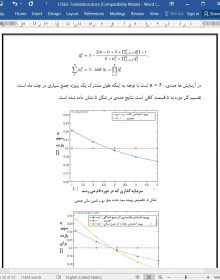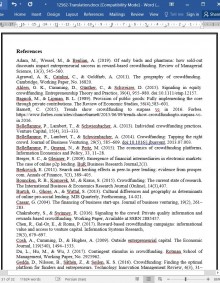
دانلود مقاله تخصیص سود در جمع سپاری مبتنی بر سرمایه گذاری با سرمایه گذاران از زمان های ورود پویا
چکیده
توزیع یک مکانیسم تخصیص سود نرمال برای پروژه های جمع سپاری مبتنی بر سرمایه گذاری در بسیاری از پلت فرم ها موجود است. به عبارت دیگر، هنگامی که سرمایه گذاری پایان می یابد ، سرمایه گذاران با همان وجوه تعهد شده تصفیه حساب می کنند. مکانیزم تخصیص حتی تحت این فرض که سرمایه گذاران به طور همزمان به پلت فرم می رسند بخوبی عمل می کند. با این حال، در عمل، سرمایه گذاران دائمی هستند، بنابراین، گزارشهای متفاوتی از زمان ورود پویا سرمایه گذاران وجود دارد. در این مقاله، ما به دنبال راه هایی برای طراحی مکانیسم های تخصیص سود مناسب برای افزایش نرخ موفقیت یک پروژه تامین مالی جمعی (جمع سپاری) مبتنی بر سرمایه گذاری هستیم. سپس ما توجه خود را به دو گروه از سرمایه گذاران پویا که به صورت متوالی به پلت فرم می رسند معطوف می کنیم. با در نظر گرفتن اندازه هر گروه ، ما قادر به تجزیه و تحلیل نرخ موفقیت یک پروژه تحت شرایط عملی مختلف هستیم. در نهایت، ما برخی از آزمایشات عددی را پیاده سازی می کنیم تا مطالعات خود را به شرایطی تعمیم دهیم که در آن (۱)بیش از دو دوره تعهد برای سرمایه گذاران وجود دارد، 2)اثر رفتار جمعی سرمایه گذاران در نظر گرفته می شود و (3)ارزش گذاری سرمایه گذاران به طور عادی توزیع می شود. نتایج اصلی ما تحت این شرایط عمومی انجام می شود.
مقدمه
به خوبی شناخته شده است که شرکت های کوچک و کارآفرینان در حین جستجوی مالی از بانک ها یا سرمایه داران عمده، با مشکلات بزرگ مقابله می کنند(Cassar 2004؛ Cosh، Cumming، & Hughes 2009). در طول مراحل اولیه تکمیل تامین مالی سنتی، تامین مالی جمعی(جمع سپاری) به عنوان یک شکل ابداعی از جستجوی سرمایه از مردم و شبکه ها، با کمترین مانع ظاهر می شود. (Bouncken، Komorek، & Kraus 2015؛ Mollick & Nanda 2015).
تمرکز مطالعه ما، تامین مالی جمعی(جمع سپاری) مبتنی بر سرمایه گذاری است که یک نوع از سرمایه گذاری است که در آن سرمایه گذاران می توانند سود مالی همچون سهام، سود، درآمد و وفاداری را به عنوان بازده دریافت کنند(Belleflamme، Omrani، & Peitz 2015). یک ویژگی که بر اهمیت پروژه های تامین مالی مبتنی بر سرمایه گذاری تاکید دارد مقدار سرمایه آن ها است.تامین مالی جمعی مبتنی بر سرمایه گذاری رشد چشمگیری از زمان شروع فعالیتها در کسب و کار (JOBS) در سال 2012 در ایالات متحده آمریکا (Ahlers ، Cumming ، Günther و Schweizer 2015) را تجربه کرده است. همانطور که (Massolution (2013 گزارش کرده است، اندازه سرمایه گذاری متوسط در تامین مالی جمعی مبتنی بر سرمایه گذاری بیشتر از ۱۰۰ برابر بزرگ تر از اندازه آن در تامین مالی جمعی مبتنی بر اهدا است. علاوه بر این، طبق گفته بارنت (۲۰۱۵)، بانک جهانی همچنین تخمین زده است که حجم کل تامین مالی جمعی مبتنی بر سرمایه گذاری تا سال ۲۰۲۰ به ۹۰ میلیارد دلار خواهد رسید و از اندازه سرمایه گذاری مخاطره آمیز پیشی خواهد گرفت. علاوه بر این، بازگشت پولی(بازده)، تامین مالی جمعی مبتنی بر سرمایه گذاری را با انواع دیگر سرمایه گذاری متفاوت می سازد. به عنوان مثال، محصولات ارایه شده توسط تامین مالی جمعی مبتنی بر پاداش معمولا محصولات ابتکاری هستند که برای بازار جدید می باشند، بنابراین سرمایه گذاران باید در این پروژه متعهد شوند تا محصولی خاص را مجددا راه اندازی کنند. با این حال، فرصت های بیشتری در تامین مالی جمعی مبتنی بر سرمایه گذاری وجود دارد، زیرا سرمایه گذاران تنها به دنبال بازگشت پولی هستند که می تواند توسط هر پروژه بالقوه ارایه شود. بنابراین با توجه به اهمیت و دشواری آن ها، تصمیم گرفتیم که پروژه های تامین مالی جمعی مبتنی بر سرمایه گذاری را به عنوان کانون پژوهش خود انتخاب کنیم.
7.نتیجه گیری
جمع سپاری به عنوان یک منبع مهم تامین مالی برای شرکت های نوپا و کارآفرینان جدید در حال ظهور است، و حجم بازار آن در سال های اخیر به میزان زیادی رشد کرده است. توجه داشته باشید که نرخ موفقیت یک مشکل اصلی در جمع سپاری ، به خصوص در جمع سپاری مبتنی بر سرمایه گذاری است که سرمایه گذاران در آن بازده مالی دریافت می کنند. واضح است که عملکرد در مرحله اولیه یک پروژه جمع سپاری برای موفقیت آن حیاتی است، در حالی که سرمایه گذاران کم تر مایل به قبول ریسک بالاتر با تعهد قبلی هستند. بنابراین، ارائه مشوق هایی به سرمایه گذاران امکان پذیر است.
Abstract
Even distribution is a normal profit allocation mechanism for investment-based crowdfunding projects on many platforms. In other words, the investors with the same pledging funds will be paid evenly when the investment ends. The even allocation mechanism works well under the assumption that the investors arrive at the platform simultaneously. However, in practice, the investors are sequential, therefore, the stories are different when considering the dynamic entry times of the investors. In this paper, we study ways to design appropriate profit allocation mechanisms to enhance the success rate of an investment-based crowdfunding project. The basic model focuses on the two-investor case, where only two investors with dynamic entry times are considered. The profit allocation mechanism is shown to have great impacts on the pledging probabilities of investors, as well as the success rate of a project. After that, we shift our focus to the two-cohort case, where dynamic investors are assumed to arrive at the platform as two sequential cohorts. By taking the sizes of each cohort into consideration, we are able to analyze the success rate of a project under various practical situations. Finally, we implement some numerical experiments to generalize our studies to the situations where (i) there are more than two pledging periods for the investors, (ii) the herding effect of the investors is considered, and (iii) the valuations of the investors are assumed to be normally distributed. Our main results still hold under these general situations.
1. Introduction
It is well recognized that small start-ups and entrepreneurs encounter great difficulties while seeking finance from banks or venture capitalists (Cassar 2004; Cosh, Cumming, & Hughes 2009), especially during their initial stages. Complementing traditional financing options, crowdfunding emerged as an innovative form of seeking finance from people and networks, with a low-barrier (Bouncken, Komorek, & Kraus 2015; Mollick & Nanda 2015).
As the focus of our study, investment-based crowdfunding is one type of crowdfunding where investors can receive financial profits such as equity, interest, revenue, and loyalty as the return (Belleflamme, Omrani, & Peitz 2015).1 One attribute that reveals the importance of investment-based crowdfunding projects experienced dramatic growth since the Jumpstart Our Business Start-ups (JOBS) Act was passed in the USA in 2012 (Ahlers, Cumming, Günther, & Schweizer 2015). As reported in Massolution (2013), the average funding size in investment-based crowdfunding is more than 100 times larger than the size in donation-based crowdfunding. In addition, according to Barnett (2015), the World Bank has also estimated that the total funding size of investmentbased crowdfunding would reach $90 billion by 2020 and surpass the size of venture capital. Moreover, the monetary return also makes investment-based crowdfunding different from other types of crowdfunding. For example, the products offered by rewardbased crowdfunding are usually innovative products which are new to the market, so investors must pledge in the project to receive the specific product. However, there can be more competitions in investment-based crowdfunding because the investors are only seeking for monetary return which can be provided by any potential project. Therefore, given their importance and difficulty, we decided to choose investment-based crowdfunding projects as the focus of our research.
7. Conclusion
Crowdfunding is emerging as an important source of finance for small start-ups and new entrepreneurs, and its market size has grown enormously in recent years. Note that success rate is the core problem in crowdfunding, especially in investment-based crowdfunding, where investors receive a financial return. It is well recognized that performance in the early stage of a crowdfunding project is crucial to its success, while investors are less willing to take on the higher risk of pledging earlier. Therefore it is intuitive to offer incentives to investors.
چکیده
1.مقدمه
2.ادبیات نظری
3. شرح مسئله
4. تحلیل مکانیسم تخصیص سود
4.1 تعهد استراتژی های سرمایه گذاران
4.2 امکان اجرای(امکان سنجی) یک پروژه
4.3 میزان موفقیت یک پروژه
5.مدل دو گروهی
6.آزمایش های عددی
6.1 چند دوره
6.2اثرگروهی (جمعی)
6.3. توزیع نرمال
7.نتیجه گیری
منابع
ABSTRACT
1. Introduction
2. Literature review
3. Problem description
4. Analyses of the profit allocation mechanism
4.1. Pledging strategies of the investors
4.2. Feasibility of a project
4.3. Success rate of a project
5. Two-cohort model
6. Numerical experiments
6.1. Multi-period
6.2. Herding effect
6.3. Normal distribution
7. Conclusion
References
- ترجمه فارسی مقاله با فرمت ورد (word) با قابلیت ویرایش، بدون آرم سایت ای ترجمه
- ترجمه فارسی مقاله با فرمت pdf، بدون آرم سایت ای ترجمه



